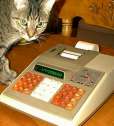Westfalia-Technik 269878
| Datasheet legend
Ab/c:
Fractions calculation
AC: Alternating current BaseN: Number base calculations Card: Magnetic card storage Cmem: Continuous memory Cond: Conditional execution Const: Scientific constants Cplx: Complex number arithmetic DC: Direct current Eqlib: Equation library Exp: Exponential/log functions Fin: Financial functions Grph: Graphing capability Hyp: Hyperbolic functions Ind: Indirect addressing Intg: Numerical integration Jump: Unconditional jump (GOTO) Lbl: Program labels LCD: Liquid Crystal Display LED: Light-Emitting Diode Li-ion: Li-ion rechargeable battery Lreg: Linear regression (2-var. stats) mA: Milliamperes of current Mtrx: Matrix support NiCd: Nickel-Cadmium recharg. batt. NiMH: Nickel-metal-hydrite rech. batt. Prnt: Printer RTC: Real-time clock Sdev: Standard deviation (1-var. stats) Solv: Equation solver Subr: Subroutine call capability Symb: Symbolic computing Tape: Magnetic tape storage Trig: Trigonometric functions Units: Unit conversions VAC: Volts AC VDC: Volts DC |
| ||||||||||||||||||||||||||||||||||||||||||||||||||||||||
Westfalia-Technik 269878
 If it looks like a duck, if it quacks like a duck, chances are it is a duck. The duck, in this case, is the Canon F-700 programmable calculator, of which this Westfalia-Technik machine appears to be an OEM version.
If it looks like a duck, if it quacks like a duck, chances are it is a duck. The duck, in this case, is the Canon F-700 programmable calculator, of which this Westfalia-Technik machine appears to be an OEM version.
This machine helped solve (or deepen, depending on your point of view) a mystery: exactly who makes these calculators? The F-700 is an unusual Canon machine, because its programming model is more like that of many Casio models. Opening the Westfalia Technik reveals... well, it reveals a circuit board made by Truly, a Hong Kong manufacturer, and a calculator chip made by NEC. Confused yet?
The programming model of this calculator is demonstrated by a program I originally wrote for the Casio fx-3600Pv; here, the additional room in program memory made it possible to make the program slightly more accurate. It computes the logarithm of the Gamma function to 8+ digits of precision, using a simple iteration to improve precision for small or negative arguments:
Kin 2 ln Kin+ 1 9 Min Kout 2 + 1 = x<=M × Min ln - MR + ( 2 × π ÷ MR ) √ ln + 1 2 1/x ÷ MR - 3 6 0 1/x ÷ MR ÷ MR x² + 1 2 6 0 1/x ÷ MR x² x² ÷ MR - 0 x-K 1 =


